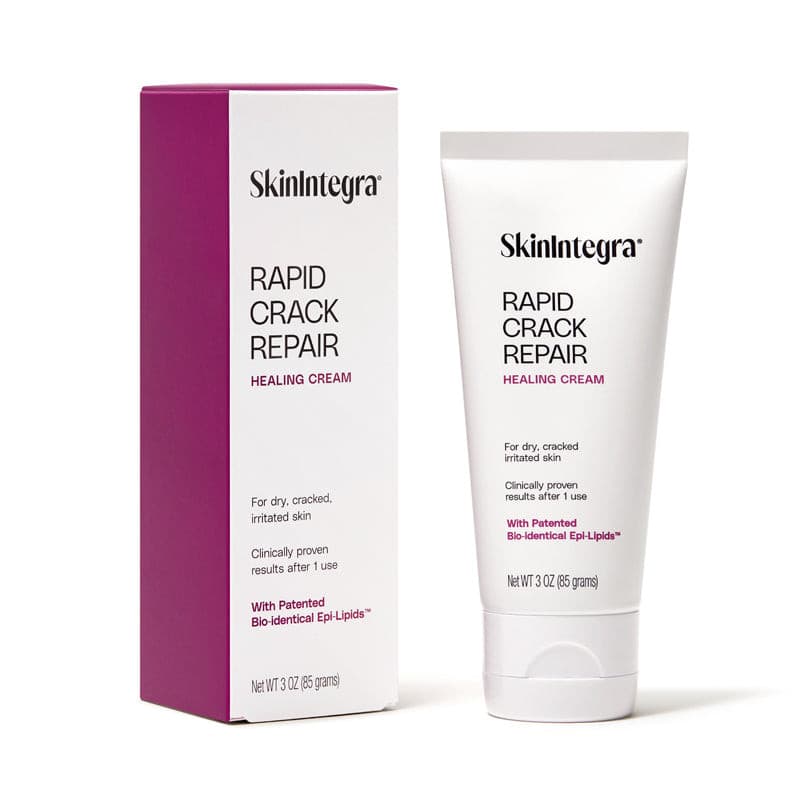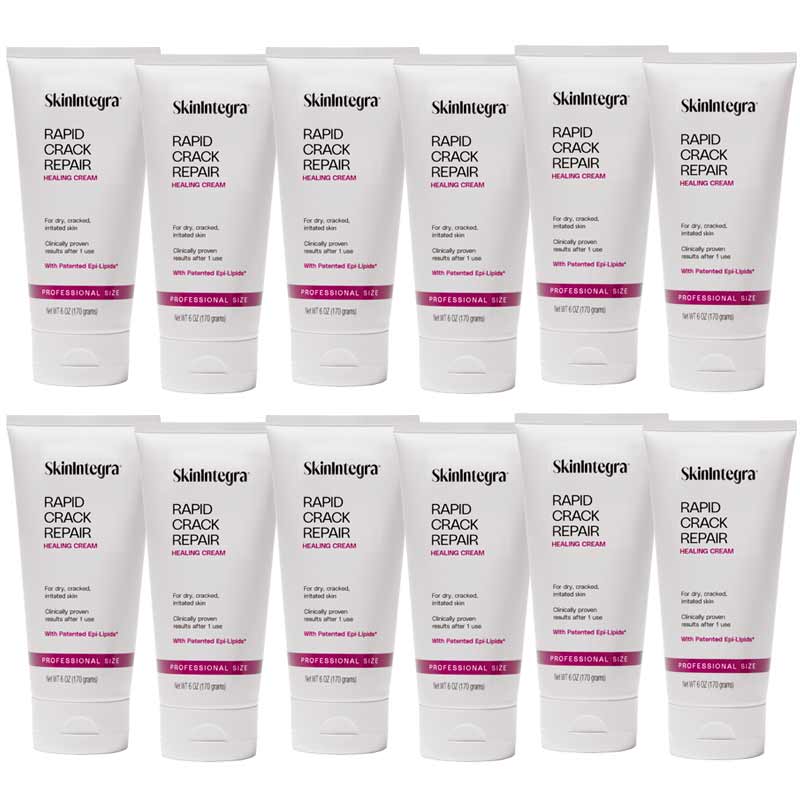Are bleeding, cracked heels causing pain and keeping you off your feet? You're not alone. Cracked heels are a common condition, especially for people with dry or diabetic-prone skin. Left untreated, they can lead to pain, bleeding, infections, and in severe cases, serious complications.
The good news: effective treatment options exist, and relief can start in just a few days with the right approach. In this guide, you'll learn what causes cracked heels to bleed, how to treat them fast, and how to prevent them from coming back.
Fast Relief for Bleeding Cracked Heels
If you're looking for quick results, start with a clinically tested barrier repair cream like SkinIntegra Rapid Crack Repair Cream. Developed with input from wound care and podiatry professionals, this formula was designed to support healing in skin that is severely compromised or at high risk of delayed repair, including in patients with diabetes.
SkinIntegra’s formulation includes:
-
25% Urea and Lactic Acid – to exfoliate and soften thickened skin, reducing the buildup that contributes to cracking
-
Hyaluronic Acid, Ceramides, Essential Fatty Acids, and Plant Oils – key components of a healthy skin barrier that promote hydration, elasticity, and repair
-
Free of skin irritants – No fragrance, dyes, parabens, petroleum derivatives, or phthalates, making it well-suited for sensitive or reactive skin
This formula is not just theoretically sound — it has been evaluated in a double-blind, head-to-head clinical trial conducted by the Western University of Health Sciences. The trial assessed patients with pedal fissures over a four-week period and compared SkinIntegra against a widely used urea-40 product.
Results showed that SkinIntegra worked faster on reducing skin cracking and dryness, with less irritation reported by patients. In addition to these findings, Dr. Dawn Buratti and other podiatrists observed that many of their patients reported visible improvement in as little as 3 days, particularly in pain, dryness, and crack depth.
Dr. Dawn Buratti, a board-certified podiatrist in Encino, California, noted:
“Patients with severely cracked heels universally say they see improvement in 3 days.”
Such outcomes are particularly significant in individuals with diabetes, where impaired circulation and compromised immune responses can delay wound healing. The rapid improvement observed with SkinIntegra suggests it is a practical option for clinicians managing dry, cracked, and fissured heels in this population.
Shop SkinIntegra Rapid Crack Repair Cream
What Causes Cracked Heels to Bleed?
Bleeding occurs when dry, thickened heel skin develops deep fissures due to pressure or friction. Common causes include:
-
Dry Skin: From dehydration, long hot showers, harsh soaps, or cold weather
-
Standing for Long Periods: Especially on hard floors
-
Ill-Fitting or Open-Backed Shoes
-
Obesity: Increases pressure on the heel
-
Neglecting Foot Care: Lack of exfoliation or moisturization
-
Medical Conditions: Diabetes, eczema, psoriasis, fungal infections, thyroid disorders
Recognizing the Symptoms
-
Deep, painful heel cracks
-
Bleeding from open fissures
-
Tenderness when walking or standing
-
Signs of infection (swelling, redness, pus)
If you have diabetes or immune-compromised skin, even small cracks should be taken seriously.
How to Heal Bleeding Cracked Heels at Home
1. Moisturize Twice Daily
Use a high-urea cream like SkinIntegra’s to deeply hydrate and soften hardened skin.
2. Gently Exfoliate (if appropriate)
Use a pumice stone or soft foot file 2–3 times a week to remove dead skin. Avoid if your heels are bleeding or if you have diabetes unless advised by a doctor.
3. Use Moisture-Locking Accessories
Apply cream at night and wear moisture-retaining socks or silicone heel sleeves to lock in hydration.
4. Avoid Harsh Soaps & Long Hot Showers
Use mild cleansers and pat feet dry instead of rubbing.
5. Wear Supportive, Closed-Back Shoes
Choose cushioned shoes that reduce heel pressure and prevent worsening cracks.
When to Seek Medical Help
Consult a podiatrist if:
-
Pain is severe or interferes with walking
-
You notice signs of infection
-
You have diabetes or poor circulation
-
Symptoms do not improve after 7–10 days of treatment
A podiatrist may perform debridement, prescribe topical medications, or recommend laser therapy or custom orthotics.
Preventing Cracked Heels from Coming Back
-
Hydrate: Drink water throughout the day
-
Apply Barrier Cream Daily: Especially after bathing
-
Avoid Walking Barefoot: Even at home
-
Choose Breathable Footwear: Materials like leather or canvas help reduce sweat buildup
-
Eat a Balanced Diet: Vitamins C, E, and omega-3s support healthy skin
-
Keep Nails Trimmed: Long toenails can change your gait and increase heel pressure
Recommended Product: SkinIntegra Rapid Crack Repair Cream

Formulated to address the full range of needs in severely dry and fissured heels, SkinIntegra’s cream:
-
Rebuilds the skin barrier using a biomimetic mix of lipids, humectants, and exfoliants
-
Is designed for diabetic-safe use and has demonstrated effectiveness in clinical observation
-
Contains no ingredients that are known to delay healing in at-risk skin
Its design reflects an understanding of the physiological needs of compromised skin — especially the balance between exfoliation and barrier restoration, which is essential when treating deep heel fissures in people with diabetes.
Shop Now | Learn More About SkinIntegra’s Clinical Results
Frequently Asked Questions
What causes cracked heels to bleed?
Dry, thick skin under pressure can split open, especially without moisturization.
Is SkinIntegra safe for diabetic skin?
Yes. It’s been clinically tested and shown to improve cracked skin quickly without harsh ingredients.
How long does it take to heal cracked heels?
With the right treatment, improvement can be seen in 3–7 days. Severe cases may take longer.
Conclusion
Bleeding cracked heels are more than a cosmetic concern — they can cause pain, restrict mobility, and create a pathway for infection, particularly in people with diabetes or chronic skin conditions. Early intervention is key. By identifying the underlying causes, applying the right moisturizing and exfoliating routine, and using clinically validated products like SkinIntegra, many people can achieve relief quickly and safely.
If symptoms persist, or if you have diabetes or other medical conditions that increase your risk of complications, consult with a podiatrist to develop a comprehensive foot care plan tailored to your needs.
Foot health starts with proactive care. The sooner you start, the faster you heal.





